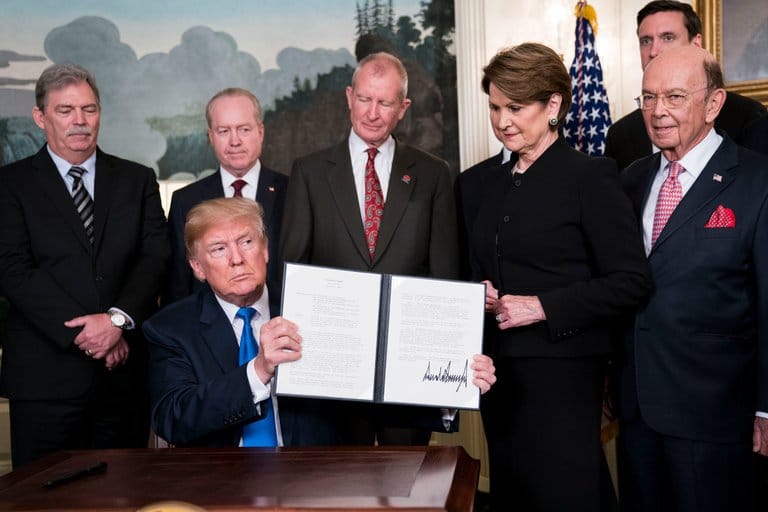UPDATE 1525 GMT: I will be on Al Jazeera English’s Inside Story to discuss how tariffs fit into Donald Trump’s war not only over trade but on international institutions and agreements — is the US now a “rogue state”?
The other panellists are Philippe LeGrain, former economic advisor to the President of the European Commission, and Pauline Loong of Asia-Analytica.
See also VideoCast with Al Jazeera: Trump’s Trade War with China
Donald Trump has fired the first shots in his trade war with China, with tariffs against $34 billion of Chinese goods taking effect on Friday.
China immediately placed tariffs on a similar amount of US products, having said previously that it lwill tax pork, soybeans, automobiles, and other goods. The Commerce Ministry said the US “has launched the biggest trade war in economic history so far”.
Protections in the Trump Administration have won an internal battle for trade confrontations. Tariffs were announced in March with implementation of 25% steel and 10% aluminum duties on Canada, Mexico, and the European Union last month. All the US targets have responded with their own measures.
Trump said on Thursday that the first wave of tariffs on Chinese good, will quickly be followed by levies on another $16 billion. And he repeated his threat of duties on up to $450 billion.
The 1st Casualties
The war is already taking American casualties, even before implementation of the first duties on Beijing.
*Supply chains for firms have been affected, driving up costs. The largest manufacturer of nails in the US, Mid-Continent Nail, has laid out dozens of workers already and warned it may soon be out of business. General Motors is among other companies warning of widespread job losses.
TrumpWatch, Day 526: General Motors — Trump’s Tariffs = Job Losses
Another example is Husco International, a Wisconsin-based manufacturing company that makes parts for companies like Ford, General Motors, Caterpillar and John Deere. With the increased cost of parts imported from China, Husco is warning that it and other American manufacturers have been put at a disadvantage versus foreign firms.
“The people it helps most of all are my competitors in Germany and Japan, who also have large parts of their supply chain in Asia but don’t have these tariffs,” said chief executive Austin Ramirez.
*US companies, facing the punishment of retaliatory tariffs, may move their production overseas. Harley-Davidson has already announced relocation, incurring the wrath of Trump.
See The Tariffs Don’t Work — Why Trump Exploded at Harley-Davidson
Razat Gaurav, the chief executive of LLamasoft, which advises companies on organizing supply chains, said that some of his clients will now set up in countries like Vietnam or Mexico. Others are postponing large investments, like new factories, and trying to avoid signing long-term contracts with suppliers.
Laura Baughman, president of Trade Partnership Worldwide, summarizes that while “over 26,000 steel and aluminum jobs would be created” because of Trump’s tariffs on steel and aluminum, “higher costs from tariffs and retaliation from America’s trading partners would also mean over 495,000 jobs lost elsewhere in the economy”.
*Tariffs on China are likely to have a larger effect on non-Chinese companies than on Beijing.
Mon-Chinese multinational corporations operating in China supply 87T of the products that will be affected by tariffs, while Chinese firms send only 13%. A 2011 study found that, for every dollar spent on an item labeled “Made in China,” 55 cents went for services produced in the United States.
*American farmers are bearing the brunt of reduced sales to China.
In anticipation of Beijing’s tariffs on soybeans, the price has fallen 15%, erasing a typical yearly profit margin of 8% to 10% for some farmers.
Brent Bible, who cultivates 5,000 acres of corn and soy in western Indiana, said farmers are now putting off purchases of tractors, grain storage facilities, and other items.


Way too early prediction: Trump will be reelected.
Economy is strong, and dems are moving too far left.
https://www.youtube.com/watch?v=OVogLdbfOfQ